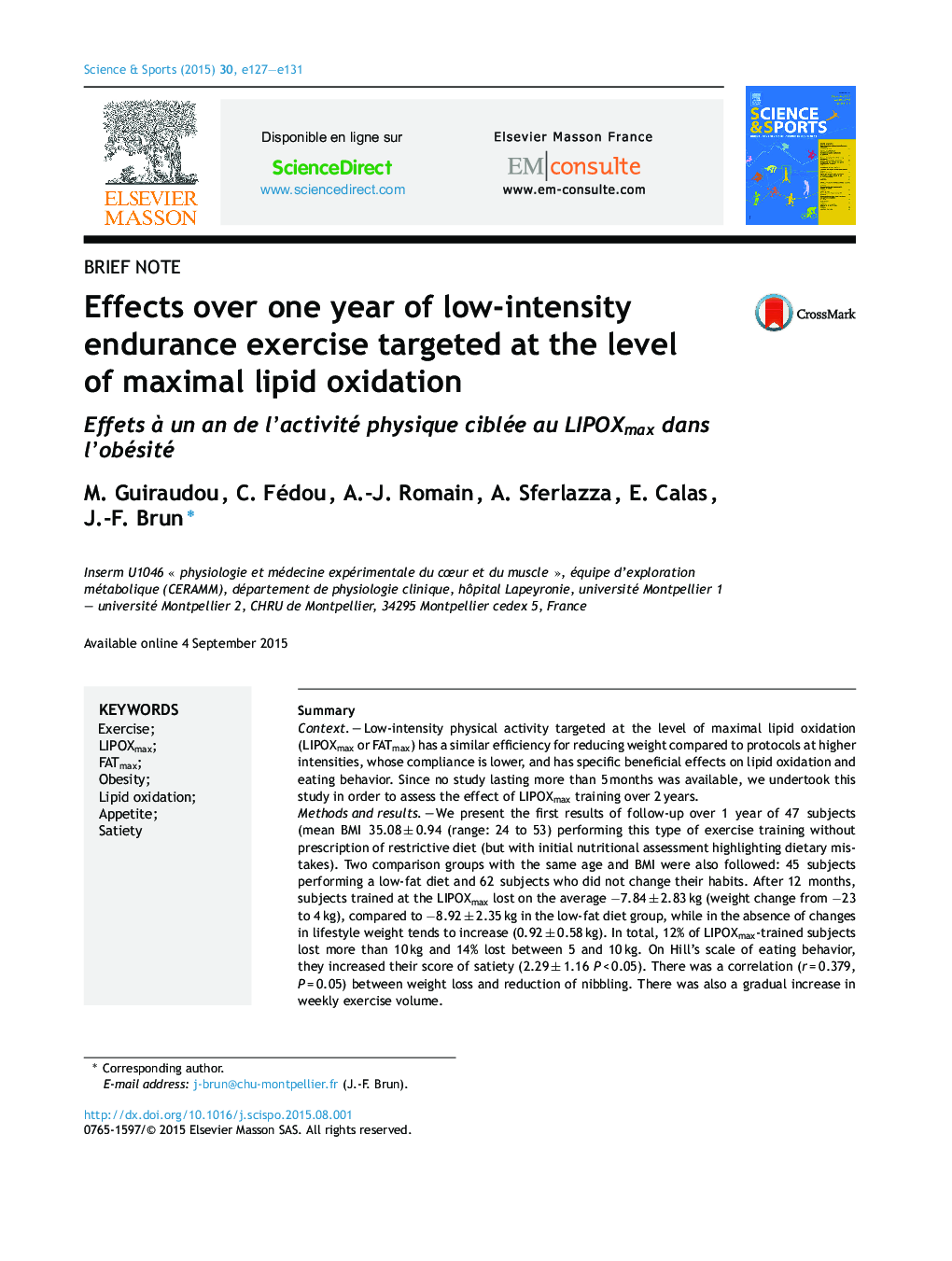| کد مقاله | کد نشریه | سال انتشار | مقاله انگلیسی | نسخه تمام متن |
|---|---|---|---|---|
| 4092672 | 1268268 | 2015 | 5 صفحه PDF | دانلود رایگان |
SummaryContextLow-intensity physical activity targeted at the level of maximal lipid oxidation (LIPOXmax or FATmax) has a similar efficiency for reducing weight compared to protocols at higher intensities, whose compliance is lower, and has specific beneficial effects on lipid oxidation and eating behavior. Since no study lasting more than 5 months was available, we undertook this study in order to assess the effect of LIPOXmax training over 2 years.Methods and resultsWe present the first results of follow-up over 1 year of 47 subjects (mean BMI 35.08 ± 0.94 (range: 24 to 53) performing this type of exercise training without prescription of restrictive diet (but with initial nutritional assessment highlighting dietary mistakes). Two comparison groups with the same age and BMI were also followed: 45 subjects performing a low-fat diet and 62 subjects who did not change their habits. After 12 months, subjects trained at the LIPOXmax lost on the average −7.84 ± 2.83 kg (weight change from −23 to 4 kg), compared to −8.92 ± 2.35 kg in the low-fat diet group, while in the absence of changes in lifestyle weight tends to increase (0.92 ± 0.58 kg). In total, 12% of LIPOXmax-trained subjects lost more than 10 kg and 14% lost between 5 and 10 kg. On Hill's scale of eating behavior, they increased their score of satiety (2.29 ± 1.16 P < 0.05). There was a correlation (r = 0.379, P = 0.05) between weight loss and reduction of nibbling. There was also a gradual increase in weekly exercise volume.ConclusionThese data of follow-up in a condition of “real life” confirm the efficacy over 1 year of this type of physical activity in obesity, and is consistent with the concept that it is favored by effects on eating behavior.
RésuméContexteL’activité physique à faible intensité ciblée sur l’oxydation maximale des lipides (LIPOXmax) a une efficacité amaigrissante au moins équivalente à celle des protocoles à plus hautes intensités dont la compliance est moindre, notamment en raison de ses effets davantage satiétogènes qu’orexigènes qui en font un modulateur du comportement alimentaire. Les études publiées sont de durée inférieure à six mois.Méthodes et résultatsNous présentons le suivi sur un an de 47 sujets d’IMC moyen 35,08 ± 0,94 (extrêmes: 24 à 53) réalisant ce type de ré-entraînement sans prescription de diète restrictive (mais avec entretien initial mettant en évidence les erreurs nutritionnelles). Par comparaison, sont suivis en parallèle deux groupes de même âge et de même IMC : 45 sujets réalisant un régime hypolipidique et 62 sujets qui ne modifient pas leurs habitudes. Les sujets entraînés au LIPOXmax ont perdu de 23 à +4 kg. À 12 mois en moyenne, ils ont perdu −7,84 ± 2,83 kg contre −8,92 ± 2,35 kg sous régime hypolipidique et +0,92 ± 0,58 kg en l’absence de modification des habitudes. Au total, 12 % des sujets entraînés au LIPOXmax ont perdu plus de 10 kg et 14 % entre 5 et 10 kg. Sur l’échelle de Hill, ils ont augmenté leur score de satiété (+2,29 ± 1,16 p < 0,05). Il y a une corrélation (r = 0,379, p = 0,05) entre perte de poids et diminution du grignotage.ConclusionCes données de suivi en condition de « vraie vie » confirment l’efficacité à 1 an de ce type d’activité physique dans l’obésité, qui semble favorisée par ses effets sur le comportement alimentaire.
Journal: Science & Sports - Volume 30, Issue 5, October 2015, Pages e127–e131
